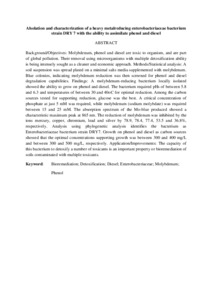Citation
Hamdan, M. H. and Othaman, M. A. and Suhaili, Z. and Shukor, M. S. and Halmi, M. I. E. and Abdullah, S. R. S. and Shamaan, N. A. and Shukor, M. Y.
(2016)
Alsolation and characterization of a heavy metalreducing enterobacteriaceae bacterium strain DRY 7 with the ability to assimilate phenol and diesel.
Indian Journal of Science and Technology, 9 (23).
pp. 1-10.
ISSN 0974-6846; ESSN: 0974-5645
Abstract
Background/Objectives: Molybdenum, phenol and diesel are toxic to organism, and are part of global pollution. Their removal using microorganisms with multiple detoxification ability is being intensely sought as a cleaner and economic approach. Methods/Statistical analysis: A soil suspension was spread plated on a minimal salts media supplemented with molybdenum. Blue colonies, indicating molybdenum reduction was then screened for phenol and diesel degradation capabilities. Findings: A molybdenum-reducing bacterium locally isolated showed the ability to grow on phenol and diesel. The bacterium required pHs of between 5.8 and 6.3 and temperatures of between 30 and 40oC for optimal reduction. Among the carbon sources tested for supporting reduction, glucose was the best. A critical concentration of phosphate at just 5 mM was required, while molybdenum (sodium molybdate) was required between 15 and 25 mM. The absorption spectrum of the Mo-blue produced showed a characteristic maximum peak at 865 nm. The reduction of molybdenum was inhibited by the ions mercury, copper, chromium, lead and silver by 78.9, 78.4, 77.4, 53.5 and 36.8%, respectively. Analysis using phylogenetic analysis identifies the bacterium as Enterobacteriaceae bacterium strain DRY7. Growth on phenol and diesel as carbon sources showed that the optimal concentrations supporting growth was between 300 and 400 mg/L and between 300 and 500 mg/L, respectively. Application/Improvements: The capacity of this bacterium to detoxify a number of toxicants is an important property or bioremediation of soils contaminated with multiple toxicants.
Download File
![[img]](http://psasir.upm.edu.my/54997/1.hassmallThumbnailVersion/Alsolation%20and%20characterization%20of%20a%20heavy%20metalreducing%20.pdf)  Preview |
|
Text (Abstract)
Alsolation and characterization of a heavy metalreducing .pdf
Download (6kB)
| Preview
|
|
Additional Metadata
Actions (login required)
 |
View Item |

